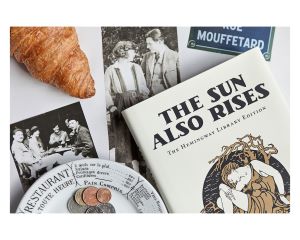
It all started when I read a negative review of a book I love on Goodreads. Nothing happens. Everyone drinks. Anti-Semitic. Cruel. It wasn't my first time reading a review like that, but it was the first time I stopped to consider what it said about me that I still called that book one of my all-time favourites.
I'd read The Sun Also Rises a few times throughout my life but hadn't been drawn to it lately. All it took was the back-and-forth banter of some internet strangers to have me pulling it off my shelf.
In my ever-expanding book collection, Hemingway is the only author with an entire shelf to himself. The famous novels, next to the failures. Thousands of pages of his correspondence. Slim volumes of short stories. Biographies covering every possible moment of his life. The man takes up a lot of space.
I decided to read it all.
I catalogued every Hemingway-related book I've ever read or wanted to read. I listed them chronologically, as he lived and wrote them, and eventually ended up with a list of 40 books. I started in January with some biographies and the first volumes of his letters and didn't get to The Sun Also Rises until March. Flipping the pages of my hardcover edition, I longed for the paperback copy I'd bought over twenty years ago, which I'd lent it to a friend, who then became an acquaintance and eventually someone I used to know. I wanted to see the pages I had folded down and the passages that stood out when I was nineteen. I wanted to see who I was when I read Hemingway for the first time.
Then I remembered the journal. 38 loose-leaf pages, handwritten, neatly stapled in the top left-hand corner. It was from my first year in university when an English professor had us write our thoughts on the books he assigned. I found it at the bottom of a box in my closet, buried under some old tax forms. I flipped to the pages about The Sun Also Rises. I had written that many of my classmates didn't like the book and saw no point in it all. I also admitted that I thought some of it was boring. I also wrote out the last paragraph of chapter 13: "It was like certain dinners I remember from the war. There was much wine, an ignored tension, and a feeling of things coming that you could not prevent happening. Under the wine I lost the disgusted feeling and was happy. It seemed they were all such nice people."
I understood very little at that age, but I understood what Hemingway was trying to tell me. In my journal, I said, "He points out things that I've always noticed and that comforts me because I know I'm not the only one who sees them."
It's an incredible thing to feel seen by an author. Hemingway, in those sentences, brought me into his story, into his own life. Falling in love with him was a silly thing to do, but there it was, the exact moment it happened.
In the end, it took me eight months to read the 40 books on my list. In a letter Hemingway wrote to his father in 1925, he said that to write the way he wanted to write, you have to show the ugly and the beautiful. "Because if it is all beautiful you can't believe in it."
Reading everything he ever wrote, his letters, and the books about him, I saw it all. Both sides, the beautiful and the ugly. So in the end, a negative review made me appreciate The Sun Also Rises, and Hemingway, even more. And for that, I'm grateful.
Florence McCambridge is a writer from Toronto, Canada, a city Hemingway hated. You will find all the books she read for her Hemingway project listed on Goodreads. Links to her published work are on her website.